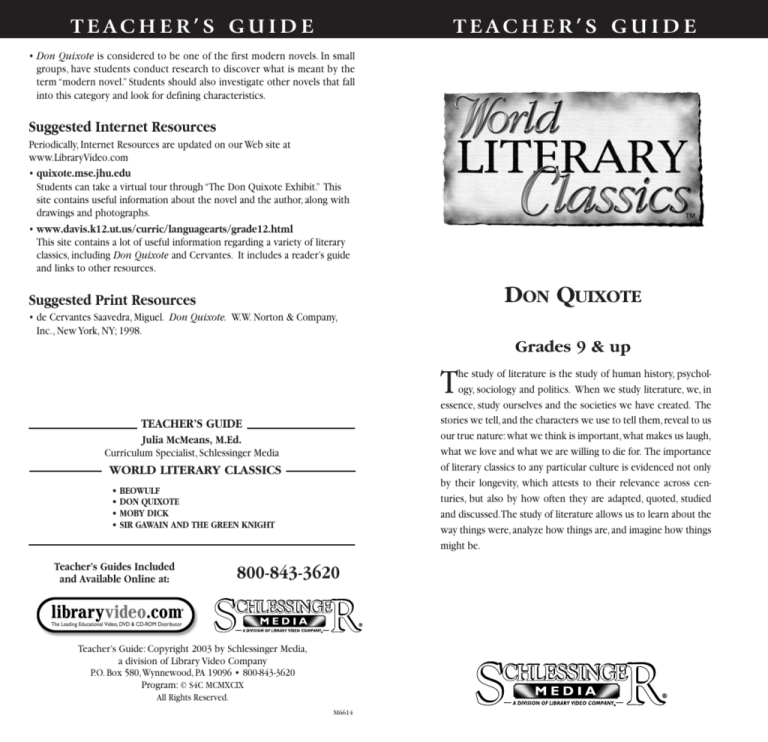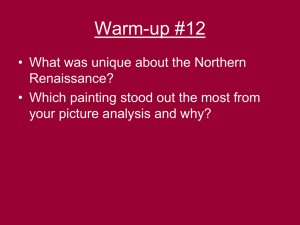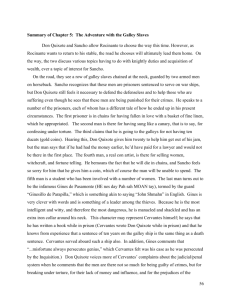
TEACHER’S GUIDE
TEACHER’S GUIDE
• Don Quixote is considered to be one of the first modern novels. In small
groups, have students conduct research to discover what is meant by the
term “modern novel.” Students should also investigate other novels that fall
into this category and look for defining characteristics.
Suggested Internet Resources
Periodically, Internet Resources are updated on our Web site at
www.LibraryVideo.com
• quixote.mse.jhu.edu
Students can take a virtual tour through “The Don Quixote Exhibit.” This
site contains useful information about the novel and the author, along with
drawings and photographs.
• www.davis.k12.ut.us/curric/languagearts/grade12.html
This site contains a lot of useful information regarding a variety of literary
classics, including Don Quixote and Cervantes. It includes a reader’s guide
and links to other resources.
DON QUIXOTE
Suggested Print Resources
• de Cervantes Saavedra, Miguel. Don Quixote. W.W. Norton & Company,
Inc., New York, NY; 1998.
Grades 9 & up
he study of literature is the study of human history, psychology, sociology and politics. When we study literature, we, in
essence, study ourselves and the societies we have created. The
stories we tell, and the characters we use to tell them, reveal to us
our true nature:what we think is important,what makes us laugh,
what we love and what we are willing to die for. The importance
of literary classics to any particular culture is evidenced not only
by their longevity, which attests to their relevance across centuries, but also by how often they are adapted, quoted, studied
and discussed.The study of literature allows us to learn about the
way things were, analyze how things are, and imagine how things
might be.
T
TEACHER’S GUIDE
Julia McMeans, M.Ed.
Curriculum Specialist, Schlessinger Media
WORLD LITERARY CLASSICS
• BEOWULF
• DON QUIXOTE
• MOBY DICK
• SIR GAWAIN AND THE GREEN KNIGHT
Teacher’s Guides Included
and Available Online at:
800-843-3620
Teacher’s Guide: Copyright 2003 by Schlessinger Media,
a division of Library Video Company
P.O. Box 580,Wynnewood, PA 19096 • 800-843-3620
Program: © S4C MCMXCIX
All Rights Reserved.
M6614
Don Quixote de la Mancha
and Miguel de Cervantes
There is an old story that one day King Phillip III of Spain was looking out of
one of the palace windows and saw a man sitting by the side of the road
reading a book.The man was laughing so hard that tears were streaming down
his face. “That man,” the king said, “is either crazy or he is reading Don
Quixote.” It is impossible to know whether this story is really true, but the fact
that it lingers as a folktale demonstrates how enormously popular Don
Quixote or The Ingenious Gentleman Don Quixote de la Mancha was
during Cervantes’ lifetime.
Don Quixote was published in two parts; Part I in 1605 and Part II in 1615. It
tells the tale of Quesada, an elderly Spanish gentleman who quite literally goes
mad from reading too many of the chivalric romances that were popular
during the 17th century. Convinced that he is a knight, he dubs himself Don
Quixote, and sets off on his horse Rosinante with his faithful companion,
Sancho Panza to battle the world’s injustices all in the name of Dulcinea, his
beloved and imaginary lady. Of course, Quixote’s madness colors everything
he sees and he mistakes windmills for monsters, an inn for a castle, and a
barber’s basin for a golden helmet.
Since its publication, Don Quixote has been called many things from a satire
of chivalric romances to an epic, and an attack on both the Catholic Church
and the Spanish politics at the time.Whatever the differences of opinion may
be regarding the genre, most would agree that Cervantes’ masterpiece is one
of the first modern novels ever written. Cervantes is credited with influencing
the likes of Swift, Defoe, Dickens, Melville, Dostoyevsky and Joyce. Even
Shakespeare, a contemporary of Cervantes, read the great Don Quixote.
The influence of Cervantes’ masterpiece is still very much evident today, from
the passing into the language of the word ‘quixotic’ (meaning foolishly
impractical), to the stage musical “Man of La Mancha” and a film of the same
name.Also, like his contemporary, Shakespeare, Cervantes has given the world
many of its most famous and used expressions, like “Honesty is the best
policy,” and “Thank you for nothing.”
Cervantes began his literary career in 1580. He wrote many plays and verses
before he penned his most famous work.Although Don Quixote was immediately successful, Cervantes himself made no money from it and died penniless.
Near to his death he wrote, “Good-bye, pleasant fancies; good-bye merry
friends, for I perceive that I am dying. My wish is to see you happy in the
other life.”
Pre-viewing Discussion
• Have a discussion with your students about literary satire. Provide examples
of satire from either other books or films.
• Discuss with your students the concept and medieval practice of chivalry.
Share with students some examples of chivalric romances so they may
better understand what Cervantes was satirizing.
Focus Questions
1.What causes Don Quixote’s madness?
2. How do the townspeople in La Mancha respond to his madness?
(Continued)
3.What is Don Quixote’s stated mission?
4. In whose name does Don Quixote perform his good deeds?
5.Why does Sancho Panza decide to accompany Don Quixote?
6.What are some examples of Don Quixote’s madness?
7.Who comes to the ultimate rescue of Don Quixote?
8. Describe the circumstances of Don Quixote’s return to La Mancha.
9.What causes Don Quixote’s death?
10. Describe how Don Quixote is dubbed a knight?
Follow-up Discussion
• In Don Quixote the protagonist goes mad from reading too many books. Is
it possible for human beings to be so influenced by something that they
saw, read or heard that they could become “crazy” or behave in a manner
that is uncharacteristic?
• Have students discuss the nature of Don Quixote’s madness.Was Quixote’s
madness a positive or a negative thing?
Follow-up Activities
• Cervantes is credited with penning some of the world’s most famous and
used expressions, most of which come from Don Quixote. In small groups,
have students conduct research to discover some of these expressions.
Useful resource: www.bartleby.com/100/733.html
• Don Quixote has been described as a chivalric romance. In small groups,
have students conduct research on the medieval code of chivalry and
courtly love. Each group can create a guide to chivalry and provide accompanying illustrations. Useful resource:
www.wmich.edu/medieval/mdvl145/resource/codes/chivalry.htm
• In small groups, have students do a study which compares and contrasts the
book Don Quixote with the program. Have students think about what material from the book was included and what was omitted; if there were any
changes that fundamentally altered the story; and why these choices were
made.
• In small groups, have students investigate satire by analyzing political cartoons.An excellent resource, complete with teacher’s guides and activities
can be found at: cagle.slate.msn.com/teacher
Important Note to Teachers:This website contains a wide variety of political
and satirical cartoons. Each teacher will have to view the website beforehand and select cartoons appropriate for his or her students. Many cartoons
reflect varying political opinions and send-ups of politicians and current
events.
• Students can experiment with writing literary satire by creating a satirical
fairy tale. For example, Cinderella may be forced to scrub an entire house
with a broken toothbrush and one arm tied behind her back. Students may
also want to experiment with writing a satirical chivalric romance.
sunsite.berkeley.edu/OMACL/Lancelot/ contains Arthurian Legends which
will help students understand what it is that they are satirizing.
(Continued)









